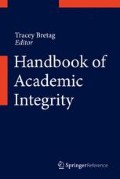Abstract
Plagiarism is a particularly complex issue because it straddles the boundary between academic integrity and academic literacy. Academic texts are widely understood to involve complex and precise expression and rhetorical sophistication. Learning to write them is rarely easy, but writers who are working through a second language face an additional challenge. Because of a trend toward increased international mobility among students, the number of inexperienced academic writers using a second language is large and rising rapidly. If, as it has been suggested, this group is especially likely to be charged with plagiarism, then there is a real danger both to the students in this group and to standards of academic integrity. This chapter examines the aspects of plagiarism which are of particular relevance to second-language writers, identifies potential problem areas, and suggests solutions.
Access this chapter
Tax calculation will be finalised at checkout
Purchases are for personal use only
References
Bennett, R. (2005). Factors associated with student plagiarism in a post-1992 university. Assessment & Evaluation in Higher Education, 30, 137–162.
Biggs, J. (1996). Enhancing teaching through constructive alignment. Higher Education, 32, 347–363.
Böhm, A., Follari, M., Hewett, A., Jones, S., Kemp, N., Meares, D., Pearce, D., & Van Cauter, K. (2004). Vision 2020: Forecasting international student mobility: A UK perspective. London: British Council.
Borg, E. (2009). Local plagiarisms. Assessment & Evaluation in Higher Education, 34, 415–426.
Brenn-White, M., & Faethe, E. (2013). English-taught master’s programs in Europe: A 2013 update. New York: Institute of International Education.
Campbell, C. (1990). Writing with others’ words: Using background reading text in academic compositions. In B. Kroll (Ed.), Second language writing: Research insights for the classroom (pp. 211–230). Cambridge: Cambridge University Press.
Chien, S.-C. (2014). Cultural constructions of plagiarism in student writing: Teachers’ perceptions and responses. Research in the Teaching of English, 49, 120–140.
Cummins, J. (2008). BICS and CALP: Empirical and theoretical status of the distinction. In B. Street & N. H. Hornberger (Eds.), Encyclopedia of language and education (2nd ed., Vol. 2, pp. 487–499). Berlin: Springer.
Davis, M. (2013). The development of source use by international postgraduate students. Journal of English for Academic Purposes, 12, 125–135.
Flowerdew, J., & Li, Y. (2007). Language re-use among Chinese apprentice scientists writing for publication. Applied Linguistics, 28, 440–465.
Gardner, D., & Davies, M. (2014). A new academic vocabulary list. Applied Linguistics, 35, 305–327.
Howard, R. M. (1995). Plagiarisms, authorships, and the academic death penalty. College English, 57, 788–806.
Howard, R. M. (1999). Standing in the shadow of giants. Stamford: Ablex.
Howard, R. M., Serviss, T., & Rodrigue, T. K. (2010). Writing from sources, writing from sentences. Writing and Pedagogy, 2, 177–192.
Hu, M. H., & Nation, P. (2000). Unknown vocabulary density and reading comprehension. Reading in a Foreign Language, 13, 403–430.
Hull, G., & Rose, M. (1989). Rethinking remediation: Toward a social-cognitive understanding of problematic reading and writing. Written Communication, 6, 139–154.
IELTS Institutions – IELTS band scores. http://www.ielts.org/institutions/test_format_and_results/ielts_band_scores.aspx
Jamieson, S. (2008). One size does not fit all: Plagiarism across the curriculum. In R. M. Howard & A. E. Robillard (Eds.), Pluralizing plagiarism: Identities, contexts, pedagogies (pp. 77–91). Portsmouth: Heinemann.
Jamieson, S. (forthcoming). Plagiarism or patchwriting? In T. Bretag (Ed.), The handbook of academic integrity. Berlin: Springer.
Li, Y., & Casanave, C. P. (2012). Two first-year students’ strategies for writing from sources: Patchwriting or plagiarism? Journal of Second Language Writing, 21, 165–180.
Mauranen, A., Ranta, E. & Hynninen, N. (2016). English as a lingua franca and EAP. In K. Hyland & P. Shaw (Eds.), The Routledge handbook of English for academic purposes (pp. 44–55). London: Routledge.
Moon, Y. (2002). Korean university students’ awareness of plagiarism in summary writings. Language Research, 38, 1349–1365.
Morley. J. Academic Phrasebank. http://www.phrasebank.manchester.ac.uk/. Accessed 21 Nov 2014.
Organisation for Economic Cooperation and Development. (2000). Education at a glance 1998: OECD indicators. Paris: OECD.
Organisation for Economic Cooperation and Development. (2014). Education at a glance 2014: OECD indicators. Paris: OECD.
Pecorari, D. (2008). Academic writing and plagiarism: A linguistic analysis. London: Continuum.
Pecorari, D. (2013). Teaching to avoid plagiarism: How to promote good source use. Maidenhead: Open University Press.
Pecorari, D. (2016). Intertextuality and plagiarism. In K. Hyland & P. Shaw (Eds.), The Routledge handbook of English for academic purposes (pp. 231–243). London: Routledge.
Pecorari, D., & Petrić, B. (2014). Plagiarism in second-language writing. Language Teaching, 47, 269–302.
Pecorari, D., & Shaw, P. (2012). Types of student intertextuality and faculty attitudes. Journal of Second Language Writing, 21, 149–164.
Pecorari, D., Shaw, P., Malmström, H., & Irvine, A. (2011). English textbooks in parallel-language tertiary education. TESOL Quarterly, 45, 313–333.
Petrić, B. (2004). A pedagogical perspective on plagiarism. NovELTy, 11, 4–18.
Roig, M. (1997). Can undergraduate students determine whether text has been plagiarized? The Psychological Record, 47, 113–122.
Roig, M. (2001). Plagiarism and paraphrasing criteria of college and university professors. Ethics & Behavior, 11, 307–323.
Selwyn, N. (2008). “Not necessarily a bad thing …”: A study of online plagiarism amongst undergraduate students. Assessment & Evaluation in Higher Education, 33, 465–479.
Shaw, P., & McMillion, A. (2008). Proficiency effects and compensation in advanced second-language reading. Nordic Journal of English Studies, 7, 123–143.
Shi, L. (2006). Cultural backgrounds and textual appropriation. Language Awareness, 15, 264–282.
Statistiska Centralbyrån. (2013). Internationell studentmobilitet i högskolan 2012/13 [International mobility in higher education from a Swedish perspective 2012/13]. Stockholm: Statistiska Centralbyrån.
Author information
Authors and Affiliations
Corresponding author
Editor information
Editors and Affiliations
Rights and permissions
Copyright information
© 2016 Springer Science+Business Media Singapore
About this entry
Cite this entry
Pecorari, D. (2016). Plagiarism, International Students, and the Second-Language Writer. In: Bretag, T. (eds) Handbook of Academic Integrity. Springer, Singapore. https://doi.org/10.1007/978-981-287-098-8_69
Download citation
DOI: https://doi.org/10.1007/978-981-287-098-8_69
Published:
Publisher Name: Springer, Singapore
Print ISBN: 978-981-287-097-1
Online ISBN: 978-981-287-098-8
eBook Packages: EducationReference Module Humanities and Social SciencesReference Module Education

